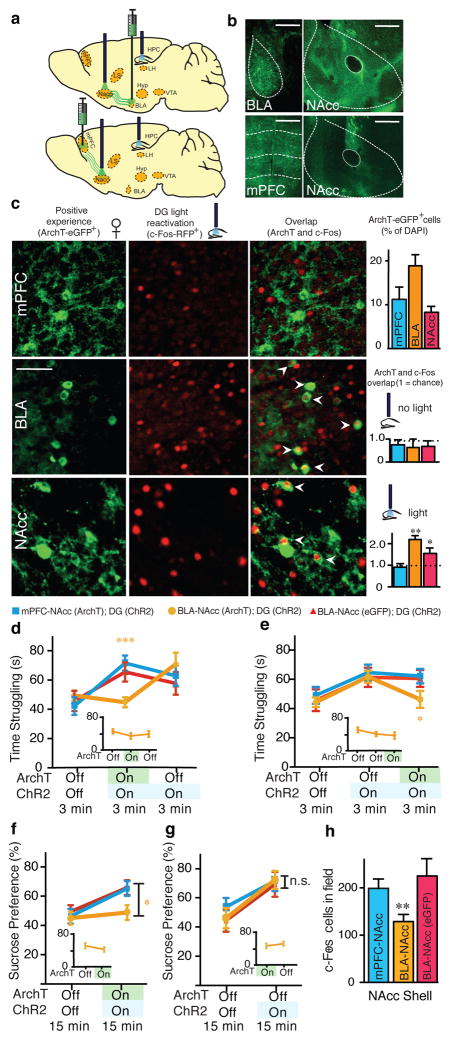Figure 3.
The antidepressant effects of an optically activated positive memory require real-time terminal activity from the BLA to the NAcc. a, Brain diagram illustrating target areas manipulated. b, Representative coronal slices showing TRE-ArchT-eGFP-positive cells in the BLA or mPFC, as well as their corresponding terminals in the NAcc. Scale bars: BLA and mPFC: 500μm, NAcc, 200μm. c, Animals were taken off Dox and initially exposed to a positive experience, which caused labeling of corresponding BLA (~18%), mPFC (~12%), or NAcc (~9%) cells with eGFP derived from AAV9-TRE-ArchT-eGFP (green, halo-like expression). Light-activation of a positive memory engram in the DG preferentially reactivated the BLA and NAcc shell cells, as measured by endogenous c-Fos expression (red, nucleus-localized), that were originally labeled by the same positive experience, while no-light stimulation groups showed levels of overlap not significantly different from chance. Arrowheads indicate double-stained cells. Scale bar: 5 μm. d–g, ArchT-mediated inhibition of BLA, but not mPFC, terminals in the NAcc prevents the DG-mediated light-induced increases in struggling (d, e) or preference for sucrose (f, g), while inhibition of BLA terminals in the NAcc without DG stimulation does not affect behavior (insets). h, ArchT- mediated inhibition of BLA, but not mPFC, terminals prevents the DG-mediated light-induced increase of c-Fos expression in the NAcc. For behavioral data, a two- way ANOVA with repeated measures followed by Bonferroni post-hoc test revealed a group-by-light epoch interaction and significant ArchT-mediated attenuation of struggling in the TST (d: F2, 99 = 7.30, P < 0.001; e: F2, 99 = 6.61, P < 0.01) or preference for sucrose water in the the SPT (f: F2, 66 = 10.66, P < 0.01). n = 12 per behavioral group. *P<0.05, **P<0.01, ***P<0.001; orange ** and *** used to denote significant differences between the stress + positive memory group vs. all other groups. For histological data, one-sample t-tests against chance overlap were performed (n = 4 per group, 3–5 slices per animal). n.s., not significant. Data are means +/− SEM.

